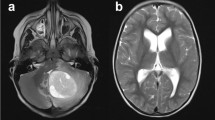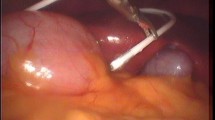Abstract
Purpose
The aim of this study was to report our experience with laparoscopic retrieval of disconnected shunt catheters in children.
Methods
Demographic data, indications for shunt insertion, time to disconnection, symptomatology, time to retrieval, operative details, length of stay and complications were recorded retrospectively. Laparoscopy was performed using two 5-mm ports and 10–12-mmHg CO2 pneumoperitoneum.
Results
Seven children (five boys, two girls) had laparoscopic retrieval of disconnected ventriculoperitoneal (VP; n = 6) and lumboperitoneal (n = 1) shunt catheters between 2006 and 2008. Median age was 8 (5–15) years. The indications for shunt insertion were hydrocephalus (n = 4), traumatic subdural haematoma (n = 1), pinealoblastoma (n = 1) and idiopathic intracranial hypertension (n = 1). Median interval from insertion to disconnection was 3 (range 1–10) years. Presenting symptoms were headache (n = 3) and neck swelling (n = 1). Three children were asymptomatic. Median referral-to-procedure time was 69 (range 2–224) days. One child underwent emergency removal of disconnected shunt with laparoscopic-assisted VP shunt insertion under the same anaesthetic. One child had a laparotomy as the catheter tip had penetrated the sigmoid mesocolon close to the bowel and could not be safely removed laparoscopically. Of the remaining five children, four had the procedure performed as day cases. There was no intra- or post-operative morbidity or subsequent shunt infections.
Conclusions
Peritoneally migrated shunt catheters have a risk of viscus injury, particularly bowel perforation. In our experience, laparoscopic retrieval of migrated shunt catheters was safe both as an emergency procedure and electively, when it was performed as a day-case basis in selected patients with excellent outcome.




Similar content being viewed by others
References
Morgan WW Jr (1979) The use of peritoneoscopy in the diagnosis and treatment of complications of ventriculoperitoneal shunts in children. J Pediatr Surg 14(2):180–181
Deinsberger W, Langhans M, Winking M, Boker DK (1995) Retrieval of a disconnected ventriculoperitoneal shunt catheter by laparoscopy in a newborn child: case report. Minim Invasive Neurosurg 38(3):123–124
Rolle U, Grafe G, Brock D, Grosser K (1998) Laparoscopy-assisted abdominal shunt revisions in children with hydrocephalus. Eur J Pediatr Surg 8(Suppl 1):60
Pierangeli E, Pizzoni C, Lospalluti A, Gigante N, Colamaria A (1999) Laparoscopic removal of two dislocated ventriculoperitoneal catheters: a case report. Minim Invasive Neurosurg 42(2):86–88
Walker DH, Langer JC (2000) Laparoscopic surgery in children with ventriculoperitoneal shunts. J Pediatr Surg 35(7):1104–1105
Esposito C, Colella G, Settimi A, Centonze A, Signorelli F, Ascione G, Palmieri A, Gangemi M (2003) One-trocar laparoscopy: a valid procedure to treat abdominal complications in children with peritoneal shunt for hydrocephalus. Surg Endosc 17(5):828–830
Yu S, Bensard DD, Partrick DA, Petty JK, Karrer FM, Hendrickson RJ (2006) Laparoscopic guidance or revision of ventriculoperitoneal shunts in children. Journal of the Society of Laparoendoscopic Surgeons 10(1):122–125
Bani A, Hassler WE (2006) Laparoscopy-guided insertion of peritoneal catheters in ventriculoperitoneal shunt procedures: analysis of 39 children. Pediatr Neurosurg 42(3):156–158
Jea A, Al-Otibi M, Bonnard A, Drake JM (2007) Laparoscopy-assisted ventriculoperitoneal shunt surgery in children: a series of 11 cases. J Neurosurg 106(6):421–425
Oshio T, Matsumura C, Kirino A, Go M, Bando Y, Manabe Y, Nakagawa Y (1991) Recurrent perforations of viscus due to ventriculoperitoneal shunt in a hydrocephalic child. J Pediatr Surg 26(12):1404–1405
Byard RW, Koszyca B, Qiao M (2001) Unexpected childhood death due to a rare complication of ventriculoperitoneal shunting. Am J Forensic Med Pathol 22(2):207–210
Digray NC, Thappa DR, Arora M, Mengi Y, Goswamy HL (2000) Silent bowel perforation and transanal prolapse of a ventriculoperitoneal shunt. Pediatr Surg Int 16(1–2):94–95
Adeloye A (1997) Protrusion of ventriculoperitoneal shunt through the anus: report of two cases. East Afr Med J 74(5):337–339
Mevorach RA, Hulbert WC, Merguerian PA, Rabinowitz R (1992) Perforation and intravesical erosion of a ventriculoperitoneal shunt in a child with an augmentation cystoplasty. J Urol 147(2):433–434
Kella N, Rathi PK, Qureshi MA (2008) Umbilical perforation: a rare complication of ventriculoperitoneal shunt. Journal of the College of Physicians & Surgeons, Pakistan 18(10):644–645
Nfonsam V, Chand B, Rosenblatt S, Turner R, Luciano M (2008) Laparoscopic management of distal ventriculoperitoneal shunt complications. Surg Endosc 22(8):1866–1870
Agha F, Amendola MA, Shirazi KK, Amendola BE, Chandler WF (1983) Unusual abdominal complications of ventriculoperitoneal shunts. Radiology 146:323–326
Handa R, Kale R, Harja MM (2007) Unusual complication of ventriculoperitoneal shunt: Anal Extrusion. MJAFI 63:82–84
Aldrich EF, Harmann P (1990) Disconnection as a cause of ventriculoperitoneal shunt malfunction in multicomponent shunt systems. Pediatr Neurosurg 16(6):309–312
Kaplan M, Ozel SK, Donmez O, Kazez A (2007) Treatment approaches for abdominal migration of peritoneal catheter of ventriculoperitoneal shunt. Turkish Neurosurgery 17(2):158–162
White JB, Raffel C, Blackwell RE (2007) A case of infertility in a patient with a ventriculoperitoneal shunt. Pediatr Neurosurg 43(2):146–148
Tsao KJ, St Peter SD, Valusek PA, Keckler SJ, Sharp S, Holcomb GW 3rd, Snyder CL, Ostlie DJ (2007) Adhesive small bowel obstruction after appendectomy in children: comparison between the laparoscopic and open approach. J Pediatr Surg 42(6):939–942
Author information
Authors and Affiliations
Corresponding author
Rights and permissions
About this article
Cite this article
Short, M., Solanki, G. & Jawaheer, G. Laparoscopic retrieval of disconnected shunt catheters from the peritoneal cavity as a day-case procedure in children—early feasibility report. Childs Nerv Syst 26, 797–800 (2010). https://doi.org/10.1007/s00381-009-1013-5
Received:
Published:
Issue Date:
DOI: https://doi.org/10.1007/s00381-009-1013-5




